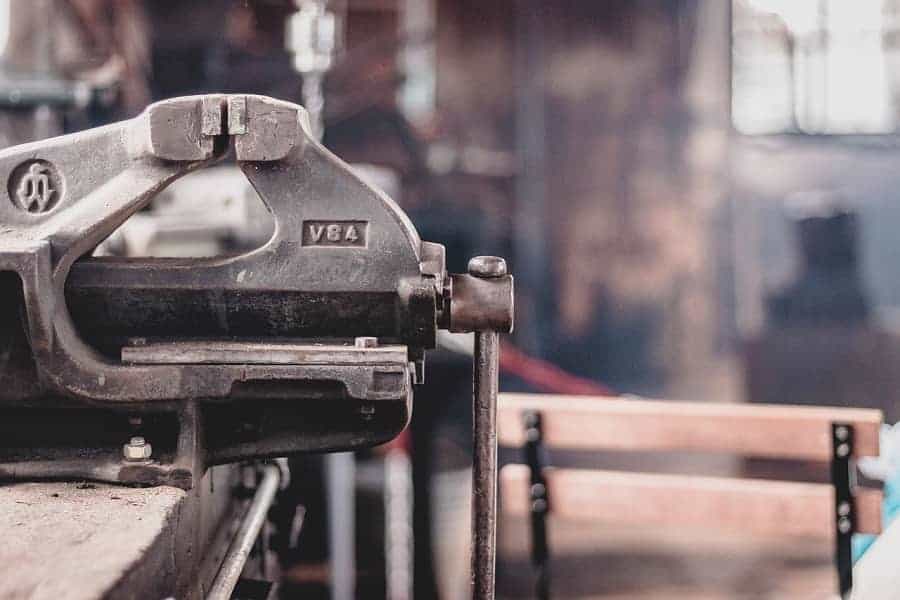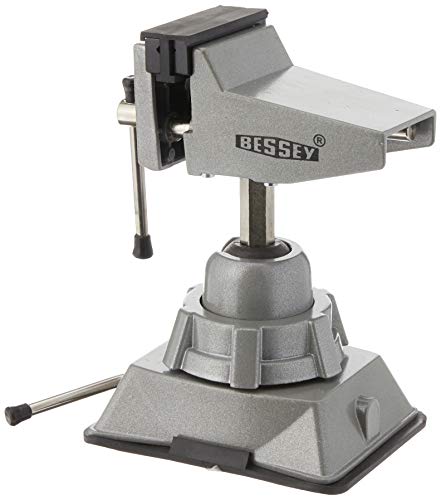Bench Vises are essentially more expensive if made in the USA, which means better quality and durability.
One brand of bench vises that stands out is Wilton. Although Wilton’s can still be hugely expensive, even a tiny 4″ one can cost around $900. It is important to note that Wilton still manufactures some models of bench vises in Taiwan. However, some of Wilton’s bench vise models like the machinist vise are proudly made in the USA. You can see the Wilton machinist’s vise and other brands (below).
Eight Types of Vises and Their Applications
There are many categories of vises, such as machinist’s vises, mechanic’s vises, and woodworking vises, to name a few. Suppose you want a high-quality and low-cost vise. In that case, my suggestion is to find an old one, fix it up, and you will save a buck; again, Wilton’s vises are very well made and incredibly durable.
I will go over eight different types of vises and their applications and hopefully provide some answers you may have about these vises. Including Machinist’s Vise, Mechanic’s Vise, Drill Press Vise, Tilting Drill Press Vise, Milling Vise, Clamp-On Vise, Multi-Angle Vise, and Woodworking Vise.
1. Machinist’s Vise
This machinist’s vise is made in the USA and is a little more precise, and is not tapped. They are made to a higher level of quality; again, they are slightly more precise. You can get them with the swivel base or the fixed base depending on your preference.
Also, machinist’s vises come in all shapes and sizes; anything from the early 1900s is pretty much what you’re going to want if you’re looking to rebuild one.
Some machinist’s vises do not have an anvil section on the back. Unlike other vises with a small anvil section (flat surface) meant to be tapped with a hammer if you are straightening the material.
2. Mechanic’s Vise
Mechanic vises are great because they are made to be tapped. You can tap material over it; you can also grab the material and tap it over the jaws.
These mechanic’s vises are going to be a little more robust and a little less refined than machinist’s vises. They are great for general work in the shop or at home. Again, mechanic’s vises are made more of a sort of versatile tool.
So, mechanic’s vises usually have an anvil (flat surface) section on the back and are available in all shapes and sizes, making them essential for shop or home use. Some mechanic’s vises even have a sturdy little hole in the anvil (flat surface) section that you can put a wedge tool in if you want to split small pieces of wood in it.
3. Drill Press Vise
A drill press vise is ideal if you’re going to be drilling into a lot of small things. These are great vises to have in the workshop. You’ll use them primarily for drilling, but you can also use them for filing and other things because they’re so easy, meaning they act like a fixed clamp.
Drilling vises also come in all shapes and sizes, and they all have different features. For example, some drill press vises are made to be tilted, so this is not precise enough to be a milling vise. However, if you need to drill a hole at a specific angle, you can tilt it and lock it in place, and drill, and you will get that angle.
The nice thing about a traditional drill press vise is that they are usually flat on the sides. You can drill into any round material, clamp it, turn it on its side, and drill in a straight line.
4. Tilting Drill Press Vise
Tilting drill press vises are great if you need a kind of vise that can give you the ability to hold the work to do a challenging job. This vise can move in different directions that the swivel base rotates 360°, and the top can go up to 90°.
5. Milling Vise
Milling vises are made to be extra precise and hold your work well so that while you’re milling, you have the least amount of vibration possible. Now, the milling vise that everybody knows about because they see it on many people’s machines is a Kurt vise.
I recommend using this verti-lock vise for milling machines; they have a wedge system that when you squeeze down, the jaws squeeze down towards the base. Also, when you use a verti-lock vise, it keeps your work from moving up as you’re tightening it.
So for milling, you’ll want to get a more robust milling machine vise that keeps the vibration to a minimum when you’re cutting metal with an end mill or a face mill.
6. Clamp-On Vise
Clamp-on vises, also called hobby vises, are small, inexpensive vises that you can mount on the bench with a clamp for easy movement.
Hobby vises are ideal for small, light projects, such as filing small knives or doing a small task. So, it’s nice that you can grip the material you’re holding reasonably well when using these clamp-on vises.
7. Multi-Angle Vise
Multi-angle vises are also called hobby vises and are inexpensive. Like clamp-on vises, they are more suited to craft projects, but they are handy. Having these big vises is excellent, but having small vises like this one is definitely important, and here’s why:
For example, if you need to clamp small things, you don’t necessarily want to clamp them in one of these big vises and crush your material. Also, sometimes you need to clamp delicate work and avoid damaging your work by getting it done with plastic vises.
8. Woodworking Vise
Woodworking vises are usually mounted on a workbench to flush with the top of the workbench. The nice thing about a woodworking vise is that you usually line up a woodworking vise with wood clamps.
Now, with wood jaws, you can clamp a bourdon, and if you wanted to use a planer to make it flat. You could have an excellent clamping on this vise, and you don’t have to worry about it marking the material.
Woodworking vises also come in all shapes and sizes. Be warned, however, that if you are going to buy a low-cost woodworking vise, make sure it has an acme style vise and not a vise that looks like a bolt.
The low-cost non-brand name store screws have a bolt like a vise and don’t hold these with acme screws. Therefore, look to purchase or rebuild a high-quality vise.
Woodworking vises also have great features; you can usually have a quick release and take them out, but don’t be put off by the secondhand prices on these. For some reason, woodworking vises are marked as a fine antique when other vises are sold cheaply.
So, woodworking vises are great; they are great for drilling and sawing and are worth having in the arsenal with the rest of the stuff in the shop or at home.
Related
- Read the full article about why are mechanics tools so expensive.
- Learn more about 16 air compressor brands that are made in the USA (Electric and gas).
- You can also read this helpful article about pellet grills made in the USA (Freestanding & Built-In)









